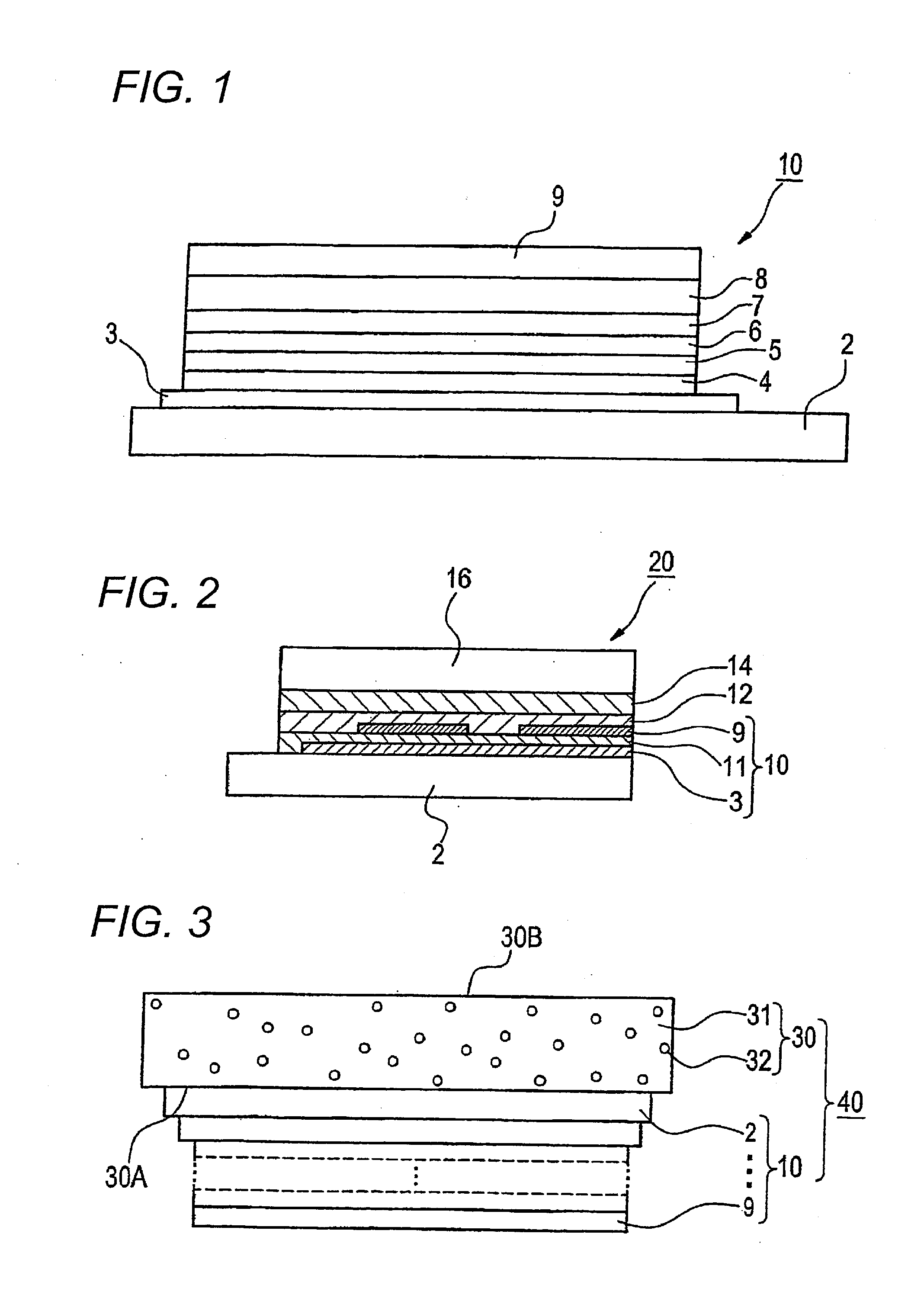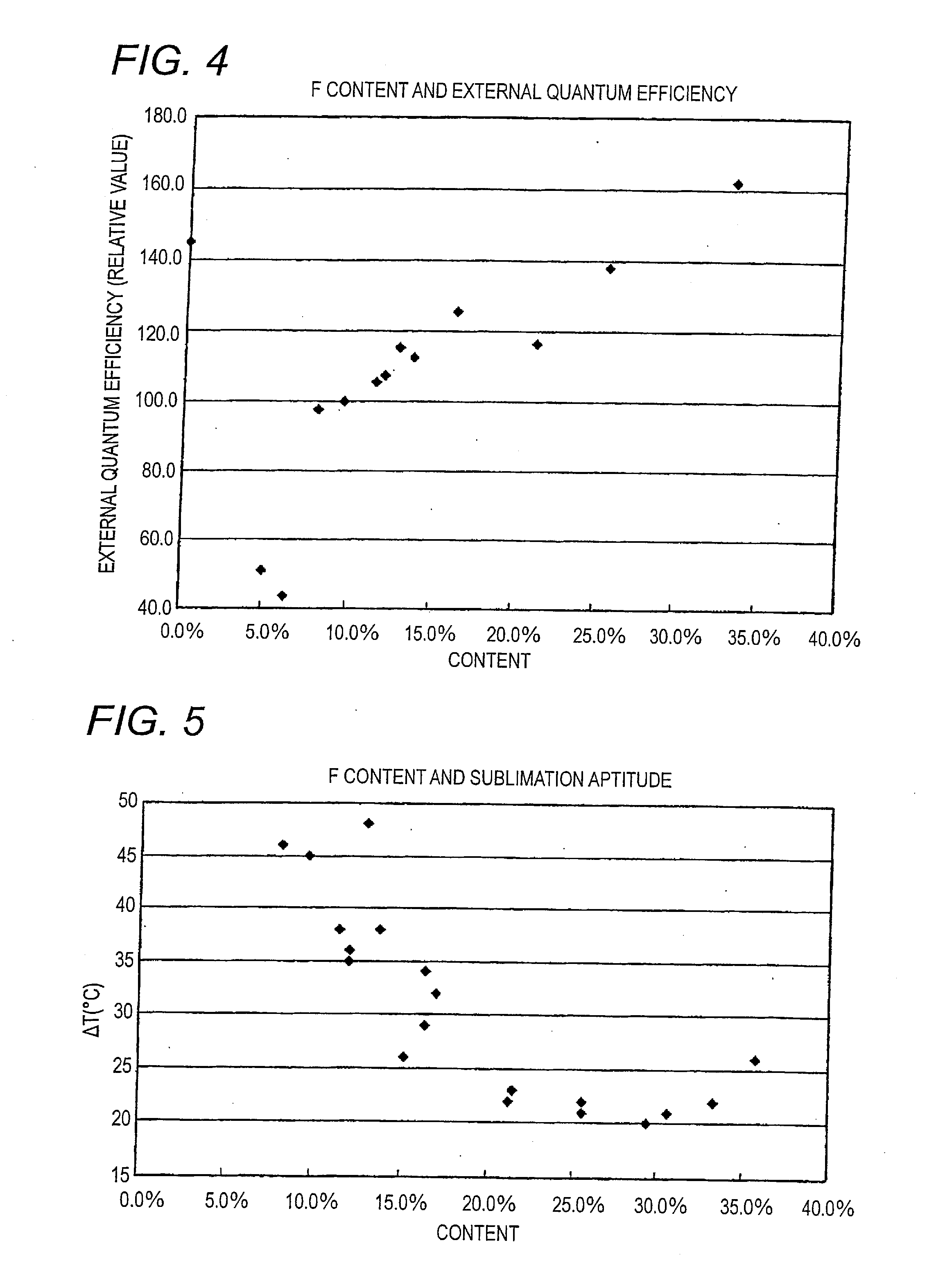Material for organic electroluminescence device and organic electroluminescence device
a technology of electroluminescence device and material, which is applied in the direction of cadmium organic compounds, group 3/13 element organic compounds, group 5/15 element organic compounds, etc., can solve the problems of low luminous efficiency and achieve low luminous efficiency, improve luminous efficiency, and reduce durability
- Summary
- Abstract
- Description
- Claims
- Application Information
AI Technical Summary
Benefits of technology
Problems solved by technology
Method used
Image
Examples
example 1
[0280]An indium tin oxide (ITO) film-provided glass substrate having a thickness of 100 μm and a size of 2.5 cm in square (manufactured by Geomatec Co., Ltd., surface resistance: 10Ω / □) was put in a washing vessel, ultrasonically washed in 2-propanol and then subjected to a UV-ozone treatment for 30 minutes. The following organic layers were successively vapor deposited on this transparent anode (ITO film) by means of vacuum vapor deposition.
[0281]First layer: CuPc (copper phthalocyanine), film thickness: 120 nm
[0282]Second layer: NPD (N,N′-di-α-naphthyl-N,N′-diphenyl)-benzidine), film thickness: 7 nm
[0283]Third layer: CBP (4,4′-di(9-carbazoyl)biphenyl), film thickness: 3 nm
[0284]Fourth layer (light emitting layer): Dopant (9% by mass), host material (91% by mass), film thickness: 30 nm
[0285]Fifth layer: First electron transport material (BAlq), film thickness: 30 nm
[0286]1 nm-thick lithium fluoride and 100 nm-thick metallic aluminum were vapor deposited in this order thereon, there...
example 2
[0294]With respect to each of the compounds of the invention and the comparative compounds, a TG curve at 1×10−2 Pa was measured in a sample amount of 20 mg, and a temperature (T(−5%)) at a [(weight loss percent)−5% point (since all of purities of the samples are 97% or more in terms of an HPLC area ratio, the −5% point was regarded as a temperature at which sublimation and evaporation were started) and a temperature (T(end)) at a point where the weight loss was completed were measured. In this respect, all of the measurements are carried out while elevating the temperature at a rate of 1° C. per minute. Also, sublimation purification was carried out at the temperature T(end) in a starting weight of 500 mg under the same pressure, and a purification yield thereof was evaluated. Also, a graph plotting a relation between a fluorine atom content and a sublimation aptitude (ΔT) is shown in FIG. 5.
[0295]Next, a device having the following constitution was prepared using the obtained mate...
example 3
[0305]An indium tin oxide (ITO) film-provided glass substrate having a thickness of 100 μm and a size of 2.5 cm in square (manufactured by Geomatec Co., Ltd., surface resistance: 10Ω / □) was put in a washing vessel, ultrasonically washed in 2-propanol and then subjected to a UV-ozone treatment for 30 minutes. The following organic layers were successively vapor deposited on this transparent anode (ITO film) by means of vacuum vapor deposition.
[0306]First layer: CuPc (copper phthalocyanine), film thickness: 120 nm
[0307]Second layer: NPD (N,N′-di-α-naphthyl-N,N′-diphenyl)-benzidine), film thickness: 7 nm
[0308]Third layer: Charge transport material, film thickness: 2 nm
[0309]Fourth layer (light emitting layer): Dopant (12% by mass), host material (88% by mass), film thickness: 30 nm
[0310]Fifth layer: First electron transport material (BAlq), film thickness: 30 nm
[0311]1 nm-thick lithium fluoride and 100 nm-thick metallic aluminum were vapor deposited in this order thereon, thereby formi...
PUM
| Property | Measurement | Unit |
|---|---|---|
| Fraction | aaaaa | aaaaa |
| Temperature | aaaaa | aaaaa |
| Temperature | aaaaa | aaaaa |
Abstract
Description
Claims
Application Information
 Login to View More
Login to View More - R&D
- Intellectual Property
- Life Sciences
- Materials
- Tech Scout
- Unparalleled Data Quality
- Higher Quality Content
- 60% Fewer Hallucinations
Browse by: Latest US Patents, China's latest patents, Technical Efficacy Thesaurus, Application Domain, Technology Topic, Popular Technical Reports.
© 2025 PatSnap. All rights reserved.Legal|Privacy policy|Modern Slavery Act Transparency Statement|Sitemap|About US| Contact US: help@patsnap.com



